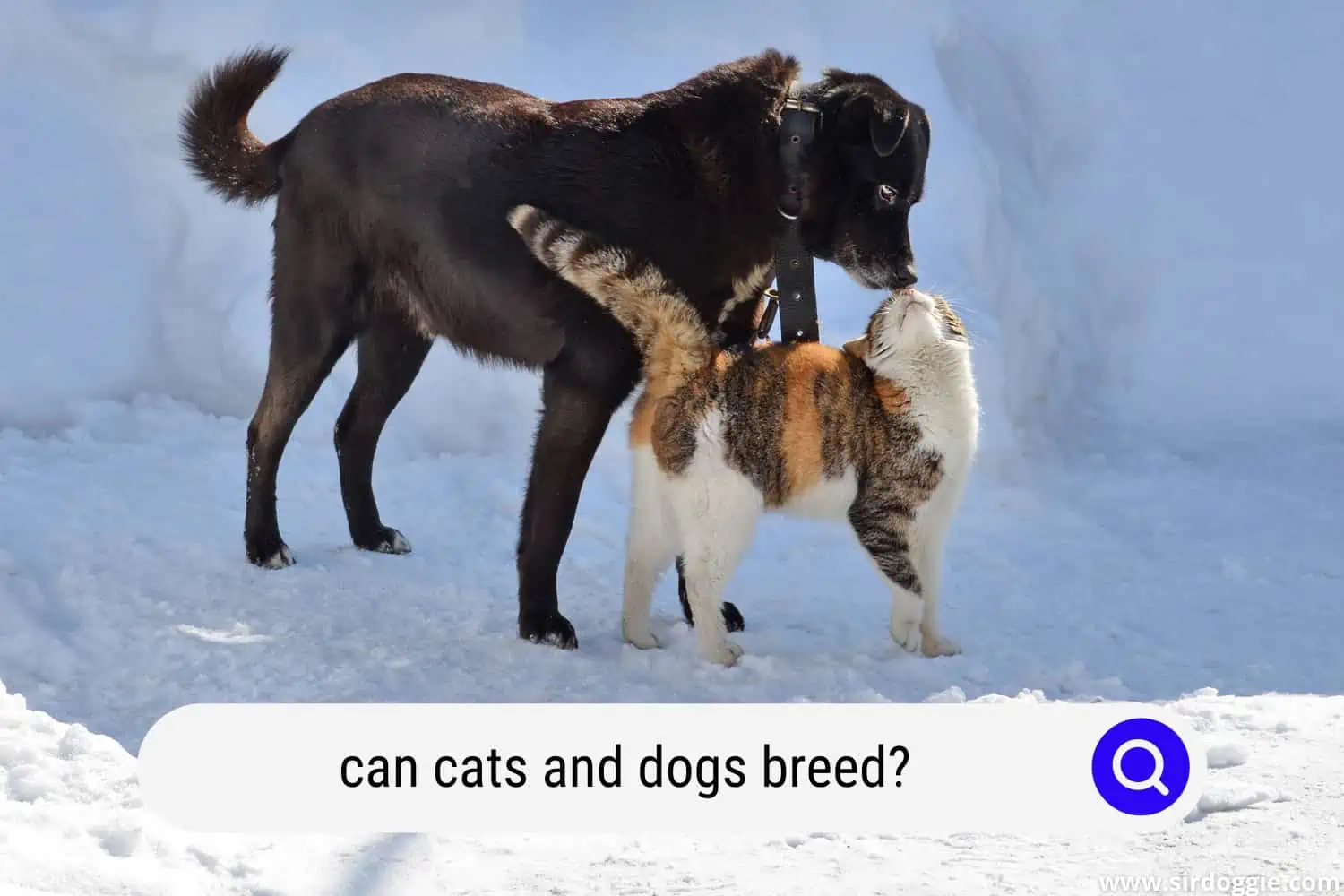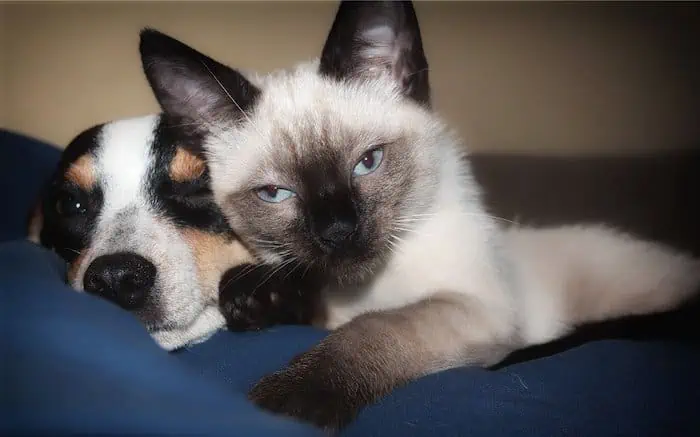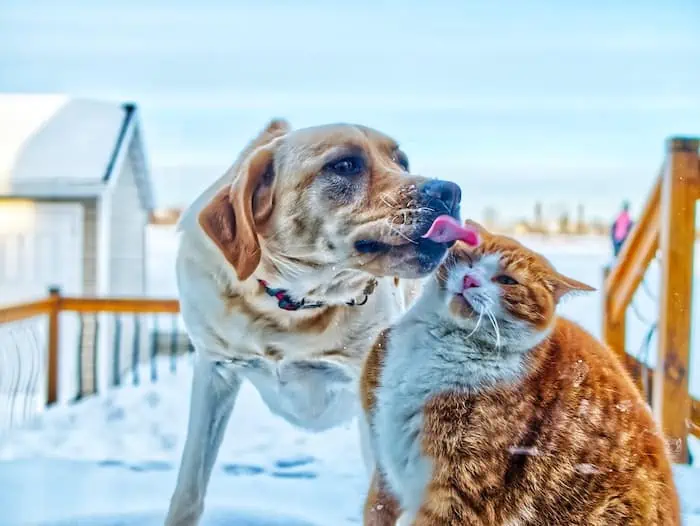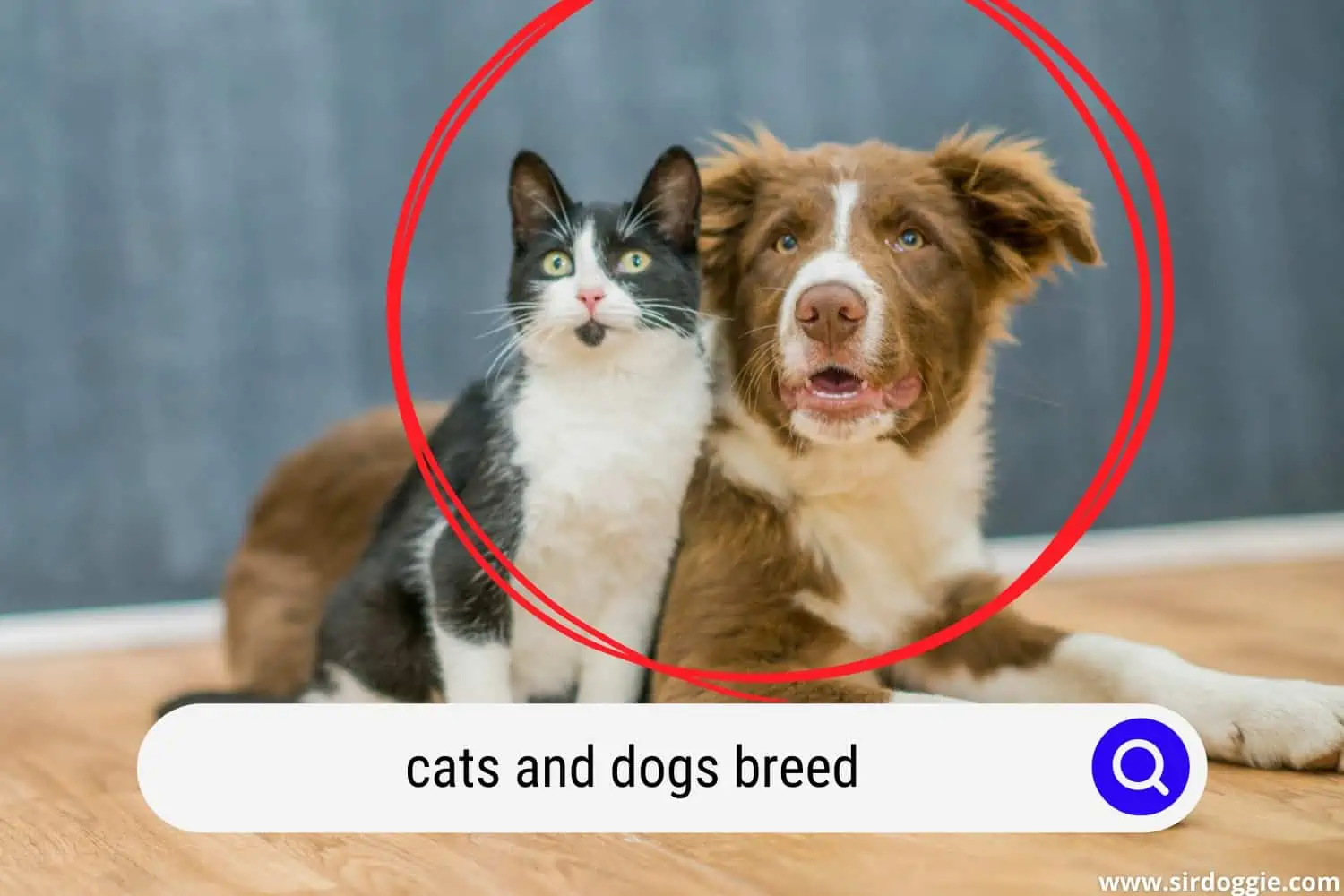Can Cats and Dogs Breed? (A Detailed Explanation)
Cats and dogs have been regarded as enemies for centuries. However, this myth of their apparent rivalry has been debunked in more recent years. In a strange twist of events, this discovery of position relationships between felines and canines has progressed to the point that many dog and cat owners are now wondering whether it is feasible or not for a dog to mate with a cat and produce offspring sharing the best of both worlds.

Can Cats and Dogs Mate?
The short and simple answer is “no.” Even if you could physically mate a dog and a cat, there would be no fertilization since they cannot interbreed. Since they are from different species and their chromosomes do not match, they cannot produce offspring.
For interbreeding to occur, two species must be closely linked in terms of their evolutionary relationships. Successful interbreeding occurs when the offspring are fertile and are capable of reproducing further as well.
Dogs have a natural propensity to mount things, whether those things are humans, furniture, toys, or other animals. However, mounting is not usually an indication of mating nor a desire to do so when it comes to dogs. Many factors can contribute to this troublesome behavior, and it may be caused by something else, such as a display of dominance.
Why Can’t Cats and Dogs Make a Hybrid?
If you spend any time looking through the various species found in the animal kingdom, you will come to understand that many closely related species can mate and produce hybrids, but this is something that never happens in the case of dogs and cats.
As an example, a liger is a cross between a tiger and a lion—two entirely distinct species. Yes, they are both members of the Felidae family, but they are still quite different creatures with very diverse behaviors, social structures, and surroundings. Oddly enough, these two have still managed to be just closely enough related when it comes to their genetic makeup and chromosomes that they have now been able to interbreed.
With other types of animals, this interbreeding is still quite rare, but scientists and researchers have come across more and more examples of this taking place. Unfortunately, when it comes to the significant differences in so many physical and genetic aspects of canines compared to felines, these two are still currently unable to mix their genetics and create a dog/cat hybrid.
What If They Mate Anyway?

When it comes to mating practices, dogs and cats are rarely seen together in such activities. You may still be asking why a hybrid of two common species couldn’t be developed by mating the two together in a more structured setting though, such as with trained and/or skilled breeders or even in a lab.
A hybrid mix that’s half puppy and half kitten may sound like an amazing concept to many, and interspecies mating has even happened and been successful in the past, so it may not be entirely impossible—at least, not in the long term. One well-known example of interbreeding being successful is the creation of the mule—a cross between a donkey and a horse.
Some breeds of animals, such as cats and dogs, are simply too distinct from one another to properly and safely intermingle. While some animals can mate and generate hybrid offspring, cats and dogs do not have genetically similar DNA, so the likelihood of them successfully combining the two species is incredibly slim.
At the time of hybrid DNA formation, the parental DNA molecules have to be what is called “homogeneous” with one another. Or, to put it another way, they have the same base pairs as each other and are similar and compatible enough for interspecies breeding to work. The mixed DNA that’s brand new can be generated because the two animals were just similar enough to allow it to work, even though that original parental DNA came from two technically different species.
The fact is that even if dogs and cats learned how to mate physically without much trouble, they simply would not ever be able to reproduce and pass on their genes due to their significant differences and the variations in their genetic makeups. It would simply be impossible by current scientific standards and the current genetic structures of cats and dogs.
Chromosomes
DNA is present in cells, and in cells is where it is organized into structures known as chromosomes, which are present in pairs on the human genome as well as in other species. Cats have a total of 38 chromosomes in their genetics, which is further divided into 19 pairs. Dogs have far more than cats—78 chromosomes—which are divided into 39 pairs.
When it comes to chromosomal pairs, closely related species—for example, lions and tigers—have the same quantity of pairs present in their genes. For them, this allows it to be possible for them to have hybrid offspring. Because dogs and cats lack matching numbers of chromosomal pairs, it is not feasible for them to have viable offspring.
Mating: Signals and the Physical Act
Cats and dogs have distinct mating behaviors and various signals that are not recognized by one another. The females of these two species go into heat, ready to reproduce, at completely different periods throughout the year. Cats and dogs also communicate in varying ways and do not appear to be particularly interested in the act of mating with one another.
Additionally, they have different reproductive organs. The sperm from a dog would be incapable of fertilizing the egg of a cat, and there is no way for a cat’s sperm to fertilize the egg of a dog (if such a situation were even attempted). Cats also have penises that are barbed rather than knotted likes dogs, allowing them to cling to the female cat when mating for them to successfully reproduce—these barbs would likely cause injury to canine females who are not designed to accept nor handle such an adaptation.
Diet
Cats are carnivores like many mammals, and this means that they are creatures that have to consume meat as their primary source of nourishment to stay alive. The proteins best suited for their digestive tracts and health requirements are those that are sourced from other animals. By comparison, dogs also eat meat, but they are omnivores, meaning they can technically eat anything. These two different digestive systems with different sets of nutritional requirements distinguish the two animals from each other, providing yet another reason why hybrid offspring could not be produced.
Consequently, animals that are distinct but still closely related—such as lions and tigers or polar and grizzly bears—share the same sequences of base pairs, implying that a hybrid is feasible between the two. However, dogs and cats do not share these matching base pair sequences, meaning they will not reproduce even if they somehow manage to mate.
Why is a Dog Mounting a Cat if it Cannot Produce Offspring?

Consequently, if a dog mounting a cat is not indicative of mating, why is he doing this?
There are reasons why your dog may be mounting other animals, including the following:
- A display of power and dominance
- Play
- Stress
- Mating season
- Health concerns
They do this not just to play but also to assert their power over others. Aggressive dogs are more prone to mount other animals as well as engage in other hostile actions that are more clearly recognizable as such. These signs involve making direct eye contact that appears frightening, standing over things, and having a high stance.
During the times that they are having fun, some dogs will mount cats and other small animals amid all the excitement. This has the potential to cause an erection as well, which is why the behavior is sometimes confused with mating or other forms of mating-related activity.
However, likely, your dog and cat are just having a good time despite how it may appear and be perceived to us by human standards. Contrary to common assumptions, cats and dogs can make good companions, and they will frequently engage in playful interactions with one another.
If your dog mounts your cat during a game of fetch or vice versa, you shouldn’t be worried. This is almost certainly a completely friendly and playful situation even if it looks otherwise.
However, they may still potentially injure each other during playing, though; therefore, you should watch their interactions. This is especially crucial if you find your dog regularly performing this sort of behavior.
Stress may also lead to this mounting behavior. A dog may be stressed out for reasons that are not known to you, so it’s essential to watch your dog to see if he is eating and sleeping well.
If stress is not the root of the problem, you may want to consider spaying or neutering your animals. While this may not eliminate your dog’s mounting desires, it will make it much easier for him to manage them.
When you observe that your dog is getting ready to mount your cat or any other item, try to distract his attention away from doing so. Some indications that your dog is preparing to mount are as follows:
- Licking
- Pawing
- Panting
If the behavior persists, the best course of action is to separate your pets for some time to observe them.
If you have difficulty keeping your dog away from your cat, you should consult with a qualified trainer. These specialists have dealt with similar situations and will know how to assist you. The solution to preventing this unpleasant habit is to redirect the dog’s energy.
Remember that mounting can also be a symptom of a health problem in some cases. This can include urinary tract infections (UTIs), skin allergies, and even urine incontinence. This is also a concern you may want to bring up with your veterinarian if all other causes seem unlikely.
The erections that your dog is having may not be due to mating instincts either: they can be a symptom of discomfort for your dog.
When this occurs, dogs will mount since it is the only way to get relief from their discomfort. If you have cause to believe that your dog is suffering from any type of health concern, you should consult your veterinarian immediately. If the problem is not resolved, it may result in potentially severe consequences.
On rare occasions, your cat may be the one mounting your dog. If this occurs, the reasons behind the behavior are just the same, and you should proceed in the same manner as if it were your dog.
Overall, mounting is not uncommon and is considered normal animal behavior, so do not be overly concerned unless the behavior is excessive or there are risks of underlying health issues attached to the behavior.
How Can You Stop This Mounting Behavior?
However, if your dog is continuously attempting to mount and hump another dog or cat, it may become more than just a little irritating.
The first thing you should try to sort out is why the dog is attempting to hump and mount the cat. Depending on the situation, the most typical cause is either boredom or excitement. Fortunately, these have the same solution.
With this being the case, you’ll want to use a toy to divert your dog’s attention away from their excessive excitement or to relieve their boredom. The concept is simple: instead of allowing your dog to hump or mount the cat, you should focus their attention on the toy instead. To be clear, you do not want the dog to hump the toy! Instead, encourage the dog to interact with the item safely and acceptably.
This strategy is referred to as ‘redirecting the behavior’ and encourages the dog to participate in a more suitable activity instead of a bad one.

FAQs
Can a Dog Mate with a Cat in a Lab?
Scientists enjoy producing hybrids, and they may be able to make a cat/dog hybrid in the future.
So far, all hybrids have descended from the same animal or plant species—for example, breeding together a Pomeranian and a Husky—and are therefore genetically identical despite their physical differences.
According to the latest research, scientists have successfully produced several new hybrids in both animals and plants.
Unfortunately, crossbreeding has several drawbacks, even when it is done between members of the same species. The majority of hybrids are infertile, and others suffer from various health problems and abnormalities.
These distinctions are attributed to the various physiological processes that distinguish the animals. The offspring of a cat and a dog would probably have difficulties living.
Even if it were possible to produce hybrid offspring from the genes of both a cat and a dog, the resulting offspring would likely not survive for very long. They would likely die early due to abnormalities and/or diseases due to a low or impaired immune system. Such hybrids do not have the appropriate genetic makeup, and they are not fit for further mating.
What About Cats? Do They Make Attempts to Mate with Dogs?
It isn’t just dogs who are causing people to believe that cats and dogs may somehow eventually produce offspring. Cats are also at fault, but their behavior is often more subtle than the outright mounting displayed by dogs. When a cat is in heat, her hormones are extremely potent, and she will act erratically, even attempting to “present” herself to a dog in some cases.
Why Pets Should Be Spayed or Neutered
Although cats and dogs cannot procreate with one another, a large portion of the undesired behaviors discussed in this article have to do with animals who haven’t been spayed or neutered. If cats are spayed, they will no longer go into heat, allowing that poor dog to relax in the warmth of its bed in peace. Most dogs will also mount less after being neutered as well, but there is an extensive list of additional advantages to having your dog neutered, too.

Family Dog Expert Author
Hi there! I’m Stuart, a devoted dog lover and family dog expert with over a decade of experience working with our furry companions. My passion for dogs drives me to share my knowledge and expertise, helping families build strong, loving bonds with their four-legged friends. When I’m not writing for SirDoggie, you’ll find me hiking, playing with my beautiful dog, or studying music.